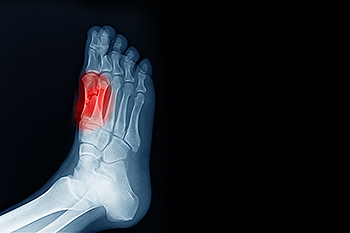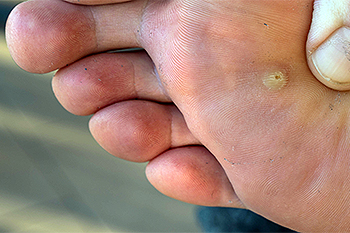Items filtered by date: April 2022
Why Live with Pain and Numbness in Your Feet?
What Can Cause Sesamoiditis?

The group of bones that are under the bottom of the big toe include the sesamoid bones. They protect specific tendons in the foot, and absorb most of the weight on the inside of the foot. The condition that is known as sesamoiditis occurs when the sesamoid bones become inflamed. They can become injured as a result of enduring a stress fracture, or from an injury that comes from repetitive motion consisting of dancing. Many patients need to have a proper diagnosis performed, which includes having an X-ray taken that can rule out a fracture. Correct treatment techniques can possibly reduce painful symptoms, in addition to protecting the foot from further injury. These can consist of wearing orthotic insoles, taking anti-inflammatory medication, or possible surgery. If you feel you have injured your sesamoid bones, it is strongly urged that you confer with a podiatrist who can help you to manage this condition, in addition to offering you correct treatment solutions.
Sesamoiditis is an unpleasant foot condition characterized by pain in the balls of the feet. If you think you’re struggling with sesamoiditis, contact one of our podiatrists of Houston Foot and Ankle Care. Our doctors will treat your condition thoroughly and effectively.
Sesamoiditis
Sesamoiditis is a condition of the foot that affects the ball of the foot. It is more common in younger people than it is in older people. It can also occur with people who have begun a new exercise program, since their bodies are adjusting to the new physical regimen. Pain may also be caused by the inflammation of tendons surrounding the bones. It is important to seek treatment in its early stages because if you ignore the pain, this condition can lead to more serious problems such as severe irritation and bone fractures.
Causes of Sesamoiditis
- Sudden increase in activity
- Increase in physically strenuous movement without a proper warm up or build up
- Foot structure: those who have smaller, bonier feet or those with a high arch may be more susceptible
Treatment for sesamoiditis is non-invasive and simple. Doctors may recommend a strict rest period where the patient forgoes most physical activity. This will help give the patient time to heal their feet through limited activity. For serious cases, it is best to speak with your doctor to determine a treatment option that will help your specific needs.
If you have any questions please feel free to contact our offices located in Inner Loop, Southwest, Greater Heights, and Pearland, TX . We offer the newest diagnostic and treatment technologies for all your foot and ankle needs.
When Is Toe Surgery Needed?
Without healthy toes, it is much more difficult to walk, run or live a normal, active life. Sometimes the toes become injured or damaged in such a way that only surgery can alleviate the problem. The most common reasons for toe surgery are changes in the shape of the toe (bunions, hammertoe, claw toe), pain in the toe joints (arthritis), and pain in the ball of the foot (metatarsalgia). Non-surgical treatment includes padding between the toes to keep them from rubbing against each other, wearing soft shoes that reduce the pain caused by toes rubbing against the top or side, and wearing inserts in your shoes to better cushion them. Surgical treatment includes releasing or strengthening tendons, straightening a toe by removing a bone, and realigning the bones of the toes. If toe pain or deformity is an ongoing problem, it is suggested that you seek guidance from a podiatrist who can examine your toes, diagnose the problem, and formulate a treatment plan that is right for you.
Foot surgery is sometimes necessary to treat a foot ailment. To learn more, contact one of our podiatrists of Houston Foot and Ankle Care. Our doctors will assist you with all of your foot and ankle needs.
When Is Surgery Necessary?
Foot and ankle surgery is generally reserved for cases in which less invasive, conservative procedures have failed to alleviate the problem. Some of the cases in which surgery may be necessary include:
- Removing foot deformities like bunions and bone spurs
- Severe arthritis that has caused bone issues
- Cosmetic reconstruction
What Types of Surgery Are There?
The type of surgery you receive will depend on the nature of the problem you have. Some of the possible surgeries include:
- Bunionectomy for painful bunions
- Surgical fusion for realignment of bones
- Neuropathy decompression surgery to treat nerve damage
Benefits of Surgery
Although surgery is usually a last resort, it can provide more complete pain relief compared to non-surgical methods and may allow you to finally resume full activity.
Surgical techniques have also become increasingly sophisticated. Techniques like endoscopic surgery allow for smaller incisions and faster recovery times.
If you have any questions please feel free to contact our offices located in Inner Loop, Southwest, Greater Heights, and Pearland, TX . We offer the newest diagnostic and treatment technologies for all your foot and ankle needs.
Maintaining Strength May Help to Prevent Falling
 Research has indicated that falling is the leading cause of many injuries in the United States. The feet are often affected when a fall has occurred, which may result in broken toes or a broken foot. The fear of falling can cause seniors to limit completing daily activities. This behavior may cause the patient to become weakened, and falling may happen more often. Falls may be prevented by becoming stronger, and this is often done through participating in an exercise program. There are measures that can be implemented in the household that may help to prevent falling as well. These can include installing grab bars in the toilet and shower area, and improving lighting in the living areas. Many people find it helpful to use a bathmat, in addition to removing worn rugs from the steps. If you would like more information about how falling can affect the feet, and how to prevent it, please consult with a podiatrist.
Research has indicated that falling is the leading cause of many injuries in the United States. The feet are often affected when a fall has occurred, which may result in broken toes or a broken foot. The fear of falling can cause seniors to limit completing daily activities. This behavior may cause the patient to become weakened, and falling may happen more often. Falls may be prevented by becoming stronger, and this is often done through participating in an exercise program. There are measures that can be implemented in the household that may help to prevent falling as well. These can include installing grab bars in the toilet and shower area, and improving lighting in the living areas. Many people find it helpful to use a bathmat, in addition to removing worn rugs from the steps. If you would like more information about how falling can affect the feet, and how to prevent it, please consult with a podiatrist.
Preventing falls among the elderly is very important. If you are older and have fallen or fear that you are prone to falling, consult with one of our podiatrists from Houston Foot and Ankle Care. Our doctors will assess your condition and provide you with quality advice and care.
Every 11 seconds, an elderly American is being treated in an emergency room for a fall related injury. Falls are the leading cause of head and hip injuries for those 65 and older. Due to decreases in strength, balance, senses, and lack of awareness, elderly persons are very susceptible to falling. Thankfully, there are a number of things older persons can do to prevent falls.
How to Prevent Falls
Some effective methods that older persons can do to prevent falls include:
- Enrolling in strength and balance exercise program to increase balance and strength
- Periodically having your sight and hearing checked
- Discuss any medications you have with a doctor to see if it increases the risk of falling
- Clearing the house of falling hazards and installing devices like grab bars and railings
- Utilizing a walker or cane
- Wearing shoes that provide good support and cushioning
- Talking to family members about falling and increasing awareness
Falling can be a traumatic and embarrassing experience for elderly persons; this can make them less willing to leave the house, and less willing to talk to someone about their fears of falling. Doing such things, however, will increase the likelihood of tripping or losing one’s balance. Knowing the causes of falling and how to prevent them is the best way to mitigate the risk of serious injury.
If you have any questions, please feel free to contact our offices located in Inner Loop, Southwest, Greater Heights, and Pearland, TX . We offer the newest diagnostic and treatment technologies for all your foot care needs.
What Causes Plantar Warts?
 Plantar warts develop on the bottom of the feet. They grow into the skin as a result of pressure that is exerted while walking or running. They can cause severe pain and discomfort, and it can be difficult to complete daily activities. Plantar warts are associated with the human papillomavirus (HPV) and live in warm and moist areas. These can include shower room floors, public pools, and locker rooms. The virus can enter the body through small cracks in the skin and wearing appropriate shoes while in these environments can help to reduce exposure. The wart appears to be a thickened area of hard skin, and they often have small black dots in the center. There are several treatment methods available, and it is strongly advised that you consult with a podiatrist if you are afflicted with plantar warts.
Plantar warts develop on the bottom of the feet. They grow into the skin as a result of pressure that is exerted while walking or running. They can cause severe pain and discomfort, and it can be difficult to complete daily activities. Plantar warts are associated with the human papillomavirus (HPV) and live in warm and moist areas. These can include shower room floors, public pools, and locker rooms. The virus can enter the body through small cracks in the skin and wearing appropriate shoes while in these environments can help to reduce exposure. The wart appears to be a thickened area of hard skin, and they often have small black dots in the center. There are several treatment methods available, and it is strongly advised that you consult with a podiatrist if you are afflicted with plantar warts.
Plantar warts can be very uncomfortable. If you need your feet checked, contact one of our podiatrists from Houston Foot and Ankle Care. Our doctors will assist you with all of your foot and ankle needs.
About Plantar Warts
Plantar warts are the result of HPV, or human papillomavirus, getting into open wounds on the feet. They are mostly found on the heels or balls of the feet.
While plantar warts are generally harmless, those experiencing excessive pain or those suffering from diabetes or a compromised immune system require immediate medical care. Plantar warts are easily diagnosed, usually through scraping off a bit of rough skin or by getting a biopsy.
Symptoms
- Lesions on the bottom of your feet, usually rough and grainy
- Hard or thick callused spots
- Wart seeds, which are small clotted blood vessels that look like little black spots
- Pain, discomfort, or tenderness of your feet when walking or standing
Treatment
- Freezing
- Electric tool removal
- Laser Treatment
- Topical Creams (prescription only)
- Over-the-counter medications
To help prevent developing plantar warts, avoid walking barefoot over abrasive surfaces that can cause cuts or wounds for HPV to get into. Avoiding direct contact with other warts, as well as not picking or rubbing existing warts, can help prevent the further spread of plantar warts. However, if you think you have developed plantar warts, speak to your podiatrist. He or she can diagnose the warts on your feet and recommend the appropriate treatment options.
If you have any questions please feel free to contact our offices located in Inner Loop, Southwest, Greater Heights, and Pearland, TX . We offer the newest diagnostic and treatment technologies for all your foot and ankle needs.



